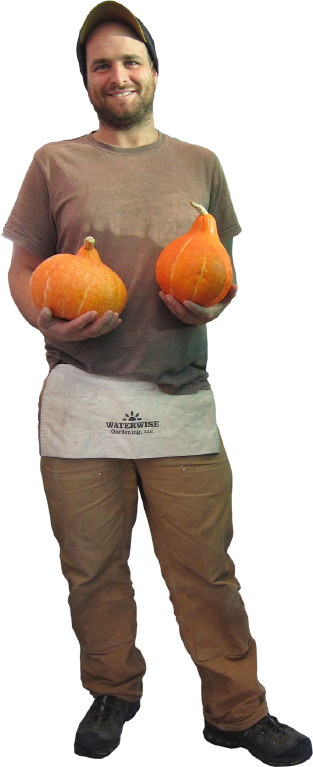New Mexico Farmer


Alex Pino’s Revolution Farm is a collection of small, leased plots in Sante Fe County, New Mexico. An active member of the Northern New Mexico Young Farmers Alliance, Alex began farming nearly 10 years ago, selling his produce at area farmers markets.
The New Mexico Farmers’ Marketing Association launched Double Up at a handful of markets in 2010. With a 2015 grant from the USDA, it is expanding Double Up to nearly 90 sites across the state including farmers markets, grocery stores, farm stands, mobile markets, and Community Supported Agriculture outlets.
Here are his words.
FARMING REALLY ENCOMPASSES what I enjoy doing. I like the connection to the land. It’s meaningful work. The land stewardship is something I have been drawn to more recently, protecting water and improving our soil.
We farm four leased properties that are all over Santa Fe County. Geographically, this is the desert. It doesn’t seem like a place where you would have a strong agricultural community or even food production, but it’s historically rich in agriculture. We have a plot in Pecos, one in Upper La Cienega, and two in the foothills southeast of downtown Santa Fe. Each is no more than a half-acre.
Our farm is what a lot of growers refer to as a diversified vegetable operation, which means we grow a lot of market vegetables and have found a niche with lettuce greens, salad greens, garlic, and some storage crops, like winter squash and radishes. We’ve got cabbage, tomatoes, cucumbers, peppers, too.
The farm has been slowly improving income every year. I would say 70 to 90 percent of our sales are farmers markets. We do one to three farmers markets a week and sell pretty much 12 months a year, depending on production and how cold it gets. The other 10 to 30 percent is restaurants and a little bit of wholesaling, but mostly it’s just direct retail sales to customers.
I’ve been involved with Double Up Food Bucks for at least two years. It’s one of those programs that actually works in the sense that the consumer is getting a really good deal and the farmer is actually able to make a living.
I think a lot of people talk about food justice, and then they do not necessarily bring up the fact that the farmer still needs to make a living. I do need to charge a certain amount for my food and figure out the cost of labor and everything else. Double Up is incentivized so that I’m still making what I need to, but then this person is getting really good, high-quality food, but they don’t have to pay out of pocket as much as somebody who’s well off.
We definitely have a big economic rift in Santa Fe. You’ve got people with second and third homes, who probably live here one or two weeks a year, and they’re great customers. But the people who are actually living here and working here, laboring and eating and feeding, cooking in their kitchens, those are the customers who farmers need because they’re going to stay here. And they’re deserving of it just as much as anybody else.
It’s important getting low-income people access to fresh local food. Generally, who you see at farmers markets are people with a lot of disposable income who are going to spend more on food. It’s a conscious decision versus someone who’s really poor who is just going to look for things that are a dollar or two at a convenience store. But healthy food – and not only healthy food, but fresh, local food – it’s important to give low-income people access to that.
Double Up has contributed to my farm’s income stream. People come by and spend five or ten dollars where they might have just spent that at a chain grocery store. Bringing that money to the farmers market, the consumer’s going to get twice the value of their dollars, more nutrient-dense food, and food that has traveled fewer miles and is fresher. The program also indirectly supports buying new equipment or hiring more workers.
The positive effects are ongoing and not even really fully understood until maybe years down the line. It’s the multiplier effect of locally spent dollars. Some research I saw shows that for every dollar spent at a local business, 45 cents are reinvested locally. For every dollar spent at a corporate chain, only 15 cents are reinvested locally. That’s three times the local investment. With Double Up, people get double the money to spend on local produce, so that’s six times the amount of money reinvested locally.
I don’t know what the downside would be, honestly.”
This is one profile in the Voices of Double Up in America storytelling series. Dig into the rest of these real-life stories here.








